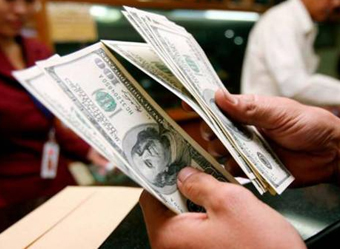The dollar bobbed above a 13-month low against a basket of major currencies on Wednesday, as investors awaited the U.S. Federal Reserve’s policy statement for clues on the course of its next monetary tightening.
Traders also kept an eye on the U.S. Senate, which narrowly agreed to open debate on a bill to end Obamacare. But the wafer-thin victory on a simple procedural matter raised questions about whether Republicans will be able to muster the votes necessary to pass any of the various approaches to repeal.
In a first of the many votes likely to come this week, the plan to repeal and replace Obamacare – passage of which is needed to fund fiscal stimulus – failed to get the 60 votes needed for approval.
“It seems like they started debate without clear view on where this will end. In a way they were able to agree to start debate precisely because neither moderates nor conservatives didn’t know the final shape. Things still look very fluid,” said a senior trader at a Japanese brokerage house.
The dollar was little moved on the latest news.
The dollar index, which measures the greenback against a basket of six major currencies, edged slightly higher to 94.109. On Tuesday, it fell as low as 93.638, its weakest level since June 2016. Against the yen, the dollar was steady at 111.89 yen, holding gains after rising 0.7 percent on Tuesday.
Against the yen, the dollar was steady at 111.89 yen, holding gains after rising 0.7 percent on Tuesday.
“The dollar had endured relentless selling over the past month as market was forced to unwind the Trump reflation trade,” said Heng Koon How, head of markets strategy for United Overseas Bank in Singapore.
Declining expectations that U.S. President Donald Trump could pull together stimulus have weakened expectations for U.S. growth and inflation.
The Fed is widely expected to keep interest rates unchanged at its two-day meeting that ends on Wednesday. Investors will be watching for any clues on whether it may raise rates again this year, and when it will begin paring its massive bond portfolio.
There is some focus on the possibility that the Fed could indicate September as the starting date for reducing its balance sheet, said Stephen Innes, head of trading in Asia-Pacific for OANDA in Singapore.
Such a hint from the Fed would not come as a big surprise, and may not provide much of a lift to the greenback, Innes wrote in a note, adding, “It will be the inflation language where a possible dovish skew will emerge.”
Sluggish inflation has kept the dollar under pressure, and led to uncertainty on whether the Fed will raise interest rates again this year.
Still, the dollar regained some ground against major currencies in the previous session, as U.S. Treasury yields rose along with U.S. equities.
The yield on the benchmark 10-year note was at 2.322 percent on Wednesday, compared with its Tuesday close of 2.326 percent, and well above Friday’s three-week low of 2.225 percent.
The euro held steady at $1.1647. On Tuesday, it rose as high as $1.17125, its highest since August 2015, and just a hair below a 2-1/2 year high, boosted by a stronger-than-expected German business survey.
The Ifo business sentiment index reached a record high, showing that Germans were “euphoric” about the country’s business climate.
The Australian dollar fell after data showed the country’s consumer inflation was surprisingly soft in the last quarter.
The Aussie shed 0.5 percent to $0.7900.
Source: Reuters



